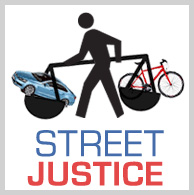Editor's note: Today Streetsblog NYC is pleased to launch "Street Justice," a new column that examines how the law, the courts, and the police affect street safety in New York. Street Justice is written by Steve Vaccaro and Adam White, two attorneys who've been valuable sources for Streetsblog over the years, adding an expert legal perspective to stories about cyclists and pedestrians injured in traffic. Their firm, the Law Office of Vaccaro & White, also pays for an ad on Streetsblog NYC's sidebar, and I'd like to make clear that the new column is not part of the advertising arrangement between Streetsblog and the firm. While it's impossible to completely separate the editorial and business decisions of an operation as small as Streetsblog, the decision to launch the Street Justice column was based on my experience relying on Vaccaro and White as sources, and on the potential for their expertise to illuminate issues of interest to our readers. I'm looking forward to running a new Street Justice every Tuesday.
- Ben Fried
If automobile insurance was sold in a classical free market, bad drivers would find it too expensive or impossible to buy insurance, preventing them from driving legally. But in New York, and throughout the United States, there is no free market for automobile insurance. Instead, insurers are required by the state to insure drivers whose records are so bad they can’t buy insurance on their own. The scheme is called the “assigned risk pool,” or by the more innocent-sounding name, the “New York Automobile Insurance Plan.”
About 1 percent of New York State-insured motorists have driving records so poor that they are insured through the assigned risk pool. These motorists are “assigned out” to insurers, who, as a condition of being permitted to write auto insurance to good risks in the New York market, must each take their pro rata share of bad risks.
One percent may seem like a small number, but these risky drivers are by no means evenly dispersed. A study conducted in 1999 found that a whopping 46 percent of Brooklyn insured motorists were in the assigned risk pool. Because auto insurance rates are underwritten in part based on geography, this means that insurance rates for even the best Brooklyn drivers were much higher, due to their proximity to such a high concentration of bad risks. While all insurance involves good risks subsidizing bad to some extent, assigned risk pools do so to such an extent that the result can hardly be called “insurance.”
“Socialism for bad drivers” is more like it.
In fairness, the high rate of assigned risk drivers in Brooklyn reflects not only the carelessness of those drivers, but also the greater inherent difficulty and risk of city as opposed to rural or suburban driving. But this simply begs the question: Why we are subsidizing bad drivers who insist on driving in risky urban settings where, ironically, safer options such as transit, walking, and bicycling abound?
As professor Jennifer Wriggins recently wrote in the Loyola of Los Angeles Law Review, assigned risk pools encourage and subsidize both driving and bad driving, because the whole point of assigned risk programs is that...
...driving is too important for the insurance market to decide who can drive or not. Driving is so important that the government must, and does, find a way to get really risky drivers insured and on the road. This has the effect of making it less safe . . . . As making coastal insurance available to homeowners who insurers do not want to insure leads to inopportune coastal development, so mandating coverage of dangerous drivers likely leads both to more driving and to more bad driving.
Isn’t it time we re-thought assigned risk pools — particularly for drivers with demonstrably bad driving records who live in New York City?
Steve Vaccaro is an attorney with the Law Office of Vaccaro & White.






